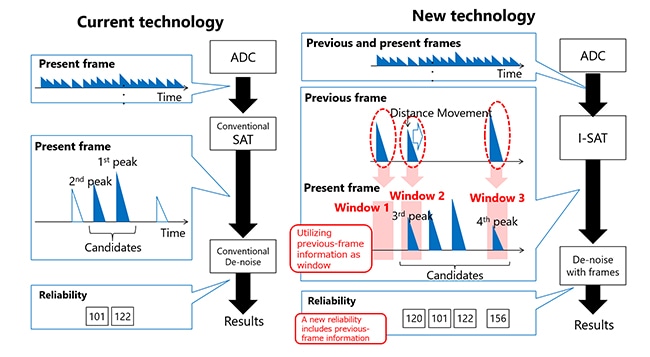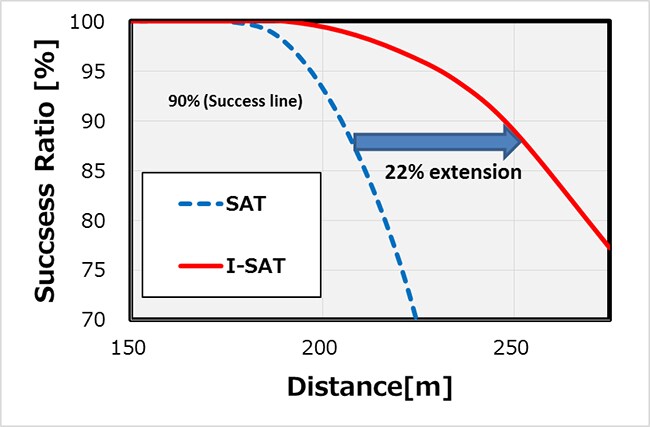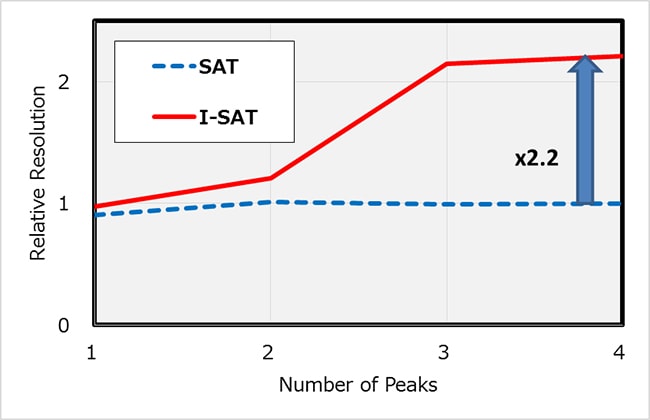Toshiba New Algorithm Greatly Improves Angular Resolution of Automotive LiDAR
April 22, 2019
Toshiba Electronic Devices & Storage Corporation
TOKYO—Toshiba Electronic Devices & Storage Corporation has developed an algorithm that delivers half the angular resolution [1] of Toshiba Group’s current automotive LiDAR [2] to achieve long-range distance object measurement and high quality 3D images.[3][4] Details of the technology were announced at COOL Chips 22 held in Yokohama on April 19.
LiDAR systems that use laser-based light detection and ranging to detect nearby vehicles and pedestrians are a key technology for more advanced driver assistant system and self-driving vehicles. To be truly effective, they must deliver long-range distance measurements and high angular resolution.
Accurate measurement over long distance in bright sunlight is a particular challenge for LiDAR, as the environmental conditions generate a lot of noise. As autonomous driving system need to detect motorcycles and small objects in distance ahead of the vehicle, LiDAR systems must offer high angular-resolution capabilities.
While averaging algorithms using multiple pixel data can suppress noise, they also degrade pixel resolution and can generate false data from random noise, which can occur when no object exists within the measurable distance.
Toshiba Corporation developed Smart Accumulation Technique (SAT) as a long-range measurement solution and presented it at ISSCC2018 [3]. SAT recognizes and selectively accumulates target reflection data by using the intensity of signals and background light information, securing accurate measurement amidst a lot of noises. Building on this, at COOL Chips 21 [4] Toshiba Electronic Devices & Storage Corporation next proposed an algorithm that performs de-noising and selects appropriate data among multiple returns based on reliability criteria. This solution resolves a problem of range-value clustering, a side effect of averaging, and enables long-range measurement with few false data points.
Even with these technologies, there is still a need to improve pixel quality and angular resolution in the horizontal direction, and toward that end Toshiba Electronic Devices & Storage Corporation has developed “Inter frame Smart Accumulation Technique (I-SAT).”
Conventional averaging methods use analog-to-digital converter (ADC) results within the present image frame only, but using it with information from the previous frame would obtain better performance. However, accumulating ADC results from the present and previous frames has two problems: relying on old results may return incorrect measurements when the target is moving; and the algorithm requires enormous memory resources to preserve hold all the ADC results of previous frames.
I-SAT resolves the problems by preserving range results, not ADC results. It defines search windows according to the distance and motion measured in the previous frame and selects additional output candidates from returns (peaks) detected within the windows of the present frame, indirectly utilizing previous-frame information. Current SAT chooses the two largest peaks as output candidates in accumulated results of the present frame. I-SAT determines search windows based on previous-frame data and adds more candidates detected in the windows, the third and fourth peaks. If there is no peak in the window, there is no influence on measurement. Among the candidates, I-SAT selects peaks according to a new level of reliability which is extended to include information from the previous frame.
This new method increases long-range resolution more than 2x (2.2x) compared to Toshiba Group’s current technology and realizes 0.1 degree resolution at up to 200m. [3][4] It improves measurable distance by 22% in the same resolution as Toshiba Group’s current technology. [3][4]The additional hardware requirement is quite small; memory size has to be increased by less than 1% [5]. Toshiba Electronic Devices & Storage Corporation will continue research into improving ranging accuracy and aims to establish a practical technology by fiscal year 2020.
Toshiba Electronic Devices & Storage also develops Silicon Photo-Multipliers (SiPM), high-sensitivity integrated optical sensors for LiDAR systems. The company continues to promote R&D in autonomous driving systems, and is committed to delivering automotive semiconductor solutions that further advance safe driving.
Notes
[1] Based on simulations conducted by Toshiba Electronic Devices & Storage Corporation in March 2019 (Success: range error ≦ 1% of range value, Reflection rate of target: 10%, Intensity of ambient light: 100 K lux)
[2] LiDAR:Light Detection and Ranging
[3] Toshiba Corporation’s technology presented at ISSCC (International Solid-State Circuits Conference) 2018 (title of paper: 20ch TDC/ADC Hybrid SoC for 240x96-pixel 10%-Reflection <0.125%-Precision 200m-Range-Imaging LiDAR with Smart Accumulation Technique)
[4] Toshiba Electronic Devices & Storage Corporation’s technology presented at COOL Chips 21 (title of paper: Data Selection and De-noising Based on Reliability for Long-Range and High-Pixel Resolution LiDAR) Toshiba Group’s current technology consists of these two technologies.
[5] Based on simulations conducted by Toshiba Electronic Devices & Storage Corporation in March 2019 (Resolution: 450 x 178 x 20 fps. Manufacturing process: 28 nm process technology)
Comparison with Toshiba Group’s current technology

Extension of measurable distance

Relative resolution vs. Number of peaks

*Company names, product names, and service names may be trademarks of their respective companies.